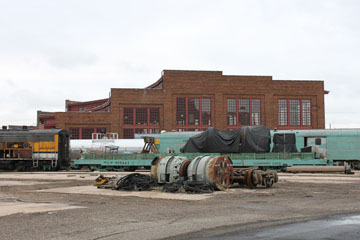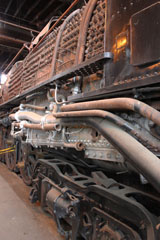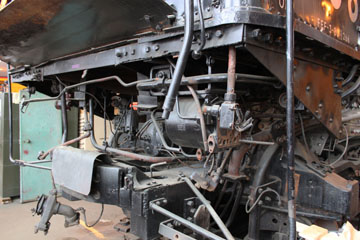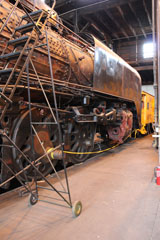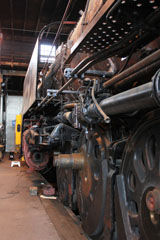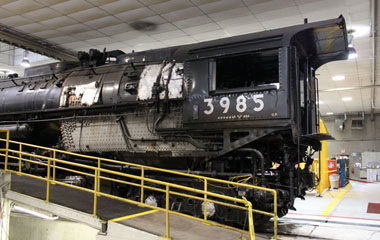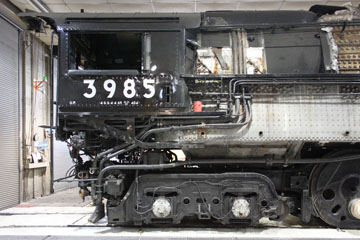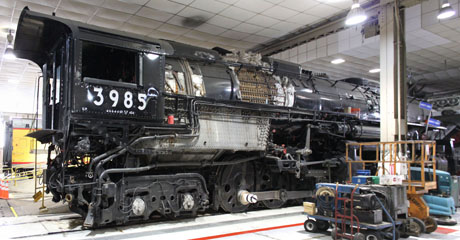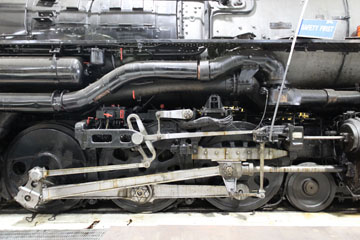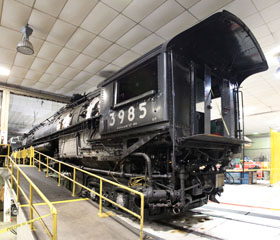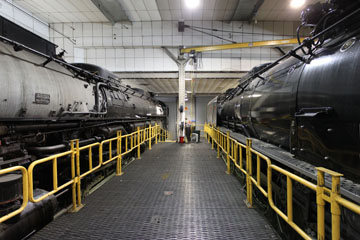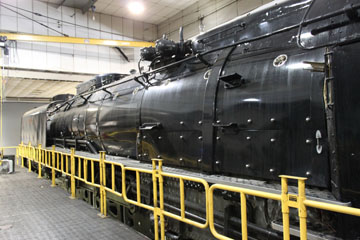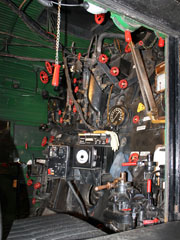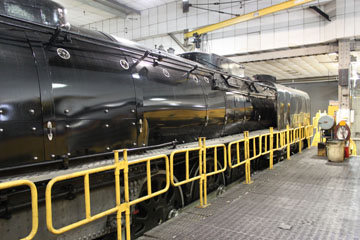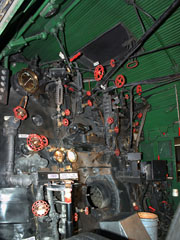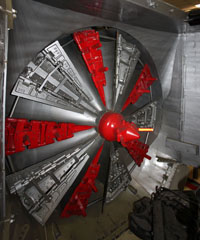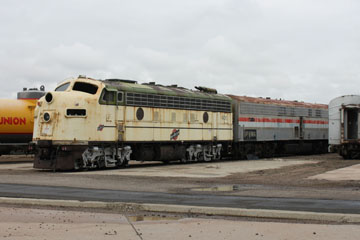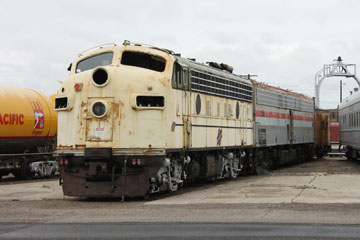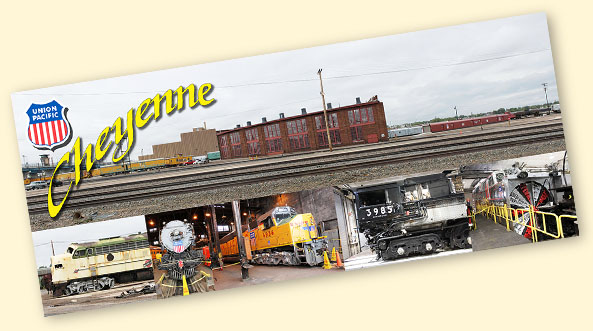

The Union Pacific roundhouse, turntable and machine shop are located in the west central part of the UP rail yard in Cheyenne, WY.
Cheyenne started life as a true railroad town. It was surveyed and platted by the Union Pacific in 1867 and named by then Chief Engineer Grenville Dodge for the Cheyenne Native American tribe. It was located near the eastern base of Sherman Hill, the highest point on UP’s main line (you can see photos of what was once Sherman Hill on the Ames Monument page of this website). Because of the steep grades on Sherman Hill, helper locomotives had to be added to passenger and freight trains, so the UP built a large locomotive and car shop complex at Cheyenne. Once they had helped a train over the hill, the helpers would cut off and move back down to Cheyenne for another train.
As time passed, the city’s importance also began to hinge on UP owned or controlled feeder lines from Orin, WY, Baldwin and Denver, CO, and south
through Trinidad, CO, to Fort Worth, TX. In 1889, the railroad spent $228,000 to build extensive car repair shops on land gifted by the city, and the large Romanesque depot building was constructed between 1886 and 1887. It was donated to the city by the Union Pacific in 1990 and now houses the Cheyenne Depot Museum.
The depot, roundhouse, turntable and machine shop were placed on the National Register of Historic Places in 1992.


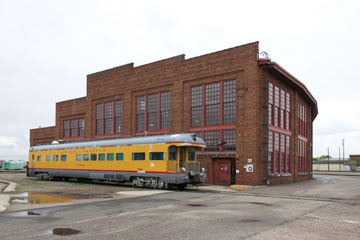
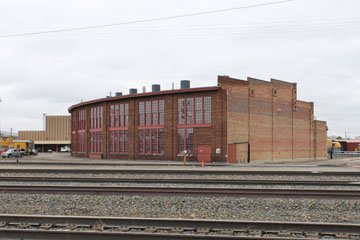
The brick roundhouse with its distinctive three tier roof was constructed in 1931 for the maintenance and storage of steam locomotives. It was originally an almost complete circular roundhouse, the largest in the UP system with forty-eight stalls, but now only seven remain.
The 126' diameter continuous span turntable and control house were built in 1941. They replaced a smaller turntable from 1911 and were designed to accommodate the massive 4-8-8-4 Big Boys. Above left, UP Business Car #5449 “Arden” was parked outside when I visited.

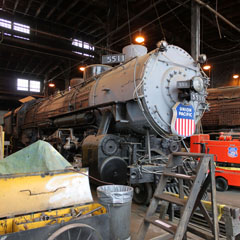
This Santa Fe (2-10-2) type locomotive was built by Baldwin in 1923. Like much of the equipment in the facilities, it was cordoned off from the public when I visited.
The name “Santa Fe” was
derived from the Atchison Topeka & Santa Fe, which ordered the first 2-10-2s in 1903 to use as pushers on the 3.25% ruling grade Raton Pass between Colorado and New Mexico. The first 2-10-2s to arrive on the Union Pacific were ten built by Baldwin and delivered in 1917. Like the Southern Pacific, however, the UP was reluctant to designate them by the name of a competitor and chose instead TTT for the Two-Ten-Two wheel arrangement. The first group was therefore designated Class TTT-1 and assigned road numbers #5000-#5009.
Between 1917 and 1924, the UP and its subsidiaries purchased one hundred and forty-four 2-10-2s, mainly from Baldwin but also eighteen from Alco and thirty-seven from Lima.
#5511 is one of fifteen TTT-6s built for the Los Angeles & Salt Lake City (#5500-#5514).
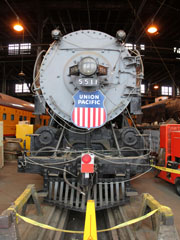
The LA&SL already owned six Santa Fe type locomotives built in 1918 by Baldwin (TTT-2 #3800-#3805) and bought ten more TTT-6s in 1924 (#5515-#5524).
The TTT-6 has an 84 sq ft grate, 368 sq ft firebox and total heating surface of 6,282 sq ft, including 1,165 sq ft superheating.
The TTT-6s were built with Young valve gear, but this was subsequently replaced with Walschaert by the Union Pacific. With
29½” x 30” cylinders and 63” drivers, they operated at a boiler pressure of 200 psi delivering 70,449 lbs tractive effort.
#5511 is the sole surviving UP Santa Fe. It was cosmetically restored some years ago for a rail show, but is not in good shape mechanically. It was also designed to pull heavy loads at slow speeds rather than passenger trains, so is unlikely to be returned to operating condition at any time in the future.
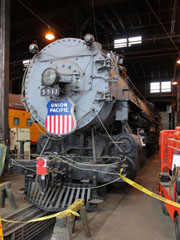

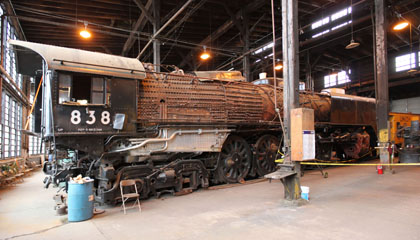
The Union Pacific bought forty-five 4-8-4s in three orders from Alco, the first twenty, #800-#819 in 1937 designated Class FEF-1 (FEF stands for the "Four-Eight-Four" wheel arrangement). You can see one of this order, #814, on the RailsWest Railroad Museum page of this website.
The second fifteen locomotives, #820-#834 delivered in 1939, were designated Class FEF-2.
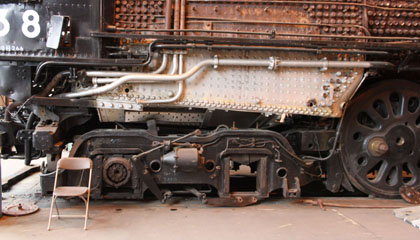
The UP ordered the last ten in 1944
(#835-#844), which were designated Class FEF-3.
They had a 100 sq ft grate area, 442 sq ft firebox and total heating surface of 5,625 sq ft, including 1,400 sq ft superheating.
With 25" x 32" cylinders and 80" drivers, operating at a boiler pressure of 300 psi, they delivered 63,750 lbs tractive effort of.
#838 is in a poor state. It appears to be kept for spare parts for #844, the other surviving FEF-3, which you can see later on this page.
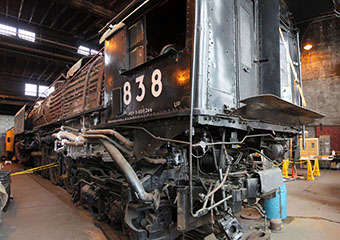
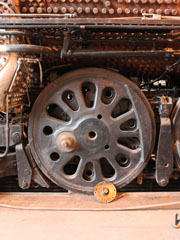

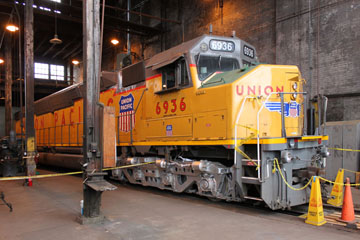
#6936 is a Centennial class diesel-electric built in 1970 for the Union Pacific by EMD to haul high speed freight. It is one of forty-seven built between 1969 and 1971, the most powerful hp rated diesel-electric locomotives ever built. At 98' 5", the DDA40X is also the longest diesel-electric unit ever built.
The first unit, #6900, was built in 1969, and the class was named "Centennial" in honour of the 100th anniversary of the driving of the Golden Spike at Promontory, UT, on 10th May 1869. You can see #6900 on the Kenefick Park page of this website and photos of the historic site on the Golden Spike NHS page.
The 'X' stood for Experimental, as they were used as testbeds for technology that would go into future EMD products. For example, the modular electronic control systems later used on EMD's Dash-2 line were first used on the DDA40X. The DDA40X was also the first to be able to load-test itself using its dynamic braking resistors as an electrical load, which meant external testing equipment was not required. A few were also fitted with air raid sirens to warn trackside staff when away from grade crossings.
#6936 weighs 521,980 lbs. It has two 16 cylinder 645E3A prime movers developing 6,600 hp to power two GM AR12 generators driving eight GM D77 traction motors, one on each axle.
The unit developed 103,000 lbs continuous tractive effort at 12 mph and 19,800 lbs at its top speed of 90mph.
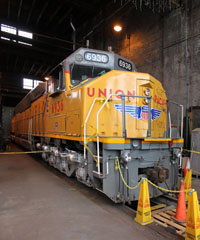
By 1980, the Centennials had run an average of 2,000,000 miles each on the road, but their service life was short. With declining freight traffic in 1980, they were taken out of service and placed in storage at Yermo, CA.
Four years later, an economic recovery brought a resurgence in demand.
Twenty-five Centennials were then returned to service but growing maintenance costs led to retirement of most of the DDA40Xs by the end of 1986.
Twelve other DDA40Xs have been preserved. As well as #6900 on the Kenefick Park page of this website, you can see #6901 on the UP #2005 page, #6913 on the Museum of the American Railroad, #6915 on the Southern California RLHS, #6916 on the Ogden Union Station, #6922 on the UP Challenger, #6930 on the Illinois Railway Museum Yard and #6944 on the National Museum of Transportation, St. Louis Yard pages.
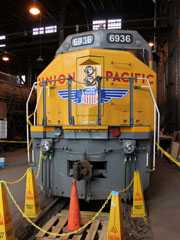

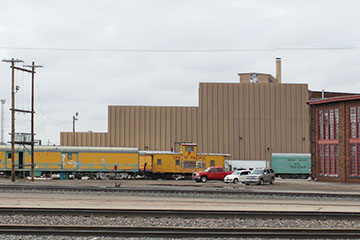
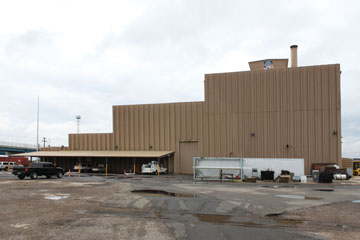
The Steam Shop is to the south east of the roundhouse. A large, concrete and brick building, it appears to be a later addition to the complex.
As the name suggests, this is where maintenance is carried out on the railroad’s operational steam locomotives, UP FEF-3 #844 and UP Challenger #3985. UP Big Boy #4014 is being restored there and various other equipment can be found there, depending on the shop’s work programme. I visited on one of the complex’s occasional open roundhouse days and was in the first group, so there were not too many of us.

Union Pacific Challenger (4-6-6-4) #3985 was undergoing work when I visited.
The first fifteen 4-6-6-4s were built for the UP by Alco in 1936 designated Class CSA-1 (#3900-#3914). In 1937, the UP bought another twenty-five designated Class CSA-2 (#3915-#3939), then a further twenty designated Class 4664-3 (#3950-#3969) in 1942. #3985 was built in June 1943, one of twenty-five Class 4664-4 (#3975-#3999). Similar to the Class 4664-3s, they were 6,500 lbs heavier as WWII material shortages meant heavier metals were used for some parts.
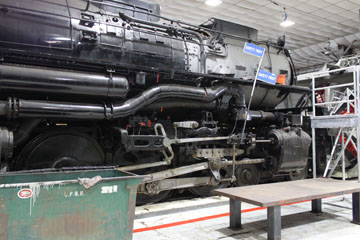
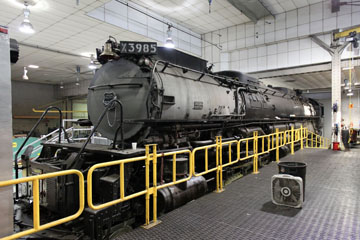
#3985 ran its last regular train service in 1957 and was retired in 1962, by which time all but two Challengers had been scrapped. After thirteen years storage in the Cheyenne roundhouse, it was placed on display outside the Cheyenne depot in 1975. Then, from 1979, a group of Union Pacific employee-volunteers began work restoring the locomotive and returned it to operational condition in 1981.
Since then, #3985 has been used to haul many passenger excursion trains and occasionally mainline freight on ferry moves.
Burnett thought that would be "a challenge for any locomotive". "It certainly is", Jeffers replied, "Let's call them 'Challengers'". Immediately after, Jeffers sent a memo to UP's Advertising Department advising that the name "Challenger" be used in all future press releases.
Challengers could easily reach 90 mph, and were very versatile, hauling passenger and freight services over most of the UP system.
The last twenty Challengers arrived in 1944. Designated Class 4664-5, they were similar to the 4664-3 but weighed an additional 7,500 lbs, again because of wartime material restrictions. They brought the UP's total roster of Challengers to one hundred and five.
The 4-6-6-4 received its name "Challenger" in 1936 during a meeting of Otto Jabelmann, Vice President of Research, William Jeffers, Executive Vice President and J. W. Burnett, General Superintendent of Motive Power and Machinery. Burnett proposed a test run for the new locomotive unassisted from Ogden to Wahsatch, UT, and then running fast to Green River, WY, before returning to Ogden with another train.
Built as a coal burner, #3985 was converted to burn oil in 1990. It weighs 634,500 lbs, 404,000 lbs on its 69” drivers. It has a 132 sq ft grate and 602 sq ft firebox with a 106" long combustion chamber. All four cylinders are 22" x 23". With a total heating surface of 6,957 sq ft, including 2,162 sq ft superheating, it operates at a boiler pressure of 280 psi delivering 97,352 lbs tractive effort. #3985 is currently the largest operational steam locomotive in the world.
You can see the only other surviving Challenger on the UP #3977 page of this website.

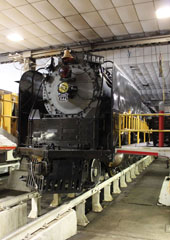
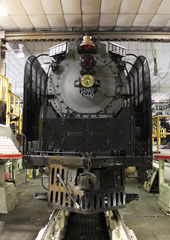
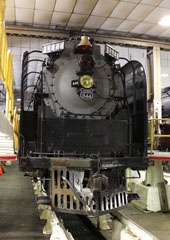
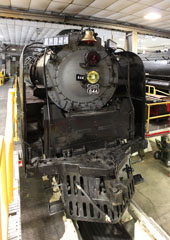
#844 was one of the last batch of FEFs (#835-#844) delivered in 1944. You can find out more about the first two orders on the UP #838 section shown earlier on this page.
#844 has a 100 sq ft grate area and 442 sq ft
firebox. Like the other FEF-3s, it was initially fitted with 69.5 sq ft of arch tubes, but these were removed by the Union Pacific in 1945. An oil burner with 5,625 sq ft total heating surface, including 1,400 sq ft superheating, it operates at a boiler pressure of 300 psi, delivering tractive effort of 63,750 lbs.
Top, UP Northern type (4-8-4) FEF-3 #844 parked over one of the pits in the Steam Shop. Lower photo, looking along one of the gangways with #3985 on the left and #844 on the right.
The Union Pacific bought forty-five 4-8-4s in three orders from Alco between 1937 and 1944. Again, perhaps reluctant to call the type by the name of a competitor (the first 4-8-4s were built for the Northern Pacific in 1927, which gave them the name), they were designated Class FEF by the UP, which stood for the Four-Eight-Four wheel arrangement.
#844 is 113' 10" long with a 50’ 11” total
wheelbase and a 22’ driver wheelbase. The engine weighs 478,860 lbs, 266,490 lbs on its 80" Boxpok drivers. SKF supplied the leading and trailing
truck roller bearings while Timken produced those for the driving axles. The locomotive has Walschaert valve gear and 25" x 32" cylinders. The tender weighs 421,550 lbs empty and has a capacity of 235,00 gallons of water and 6,000 gallons of fuel oil.
Right, a view of the controls from the engineer’s side of the cab.
#844 was the last steam locomotive delivered to the Union Pacific and
still operates (you can see it steaming through Bailey Yard, North Platte, NE, on the Golden Spike Tower page of this website).
It is the only steam locomotive never retired by a US Class I railroad.
Above, looking along the side of #844. Right, a view from the fireman’s side of the cab.
The FEFs operated over most of the UP system, initially on fast passenger trains, like the Overland Flyer, Los Angeles Limited, Challenger and Portland Rose, but, as diesels took over, they were reassigned to freight. #844 saw its last revenue service hauling freight in 1959. It was then reserved for excursion work in 1960. Renumbered #8444 for a time because of a conflicting use of #844 on a diesel, it regained its original number in 1969 after the diesel retired.

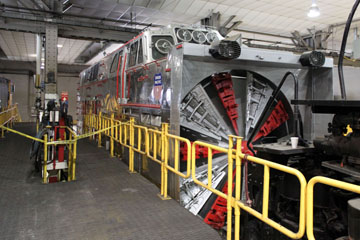
Union Pacific Rotary Snowplow #900082 was designed by the Union Pacific and built in the Omaha, NE, shops in 1971.
Although it doesn’t see service very often, each Fall it is tested in case it is required for use.
Like all rotaries, #900082 needs a locomotive attached to move it backward and forward. An EMD 567 engine powers a generator to supply electric power to the traction motors that turn the rotary blades. The cab has a console for the plow operator and a second set of controls (throttle, reverse, automatic and independent brake valves) for the locomotive engineer.
You can see UP Rotary Snowplow #900075 on the Illinois Railway Museum Yard page of this website and #900081 on the National Museum of Transportation, St. Louis Yard page.

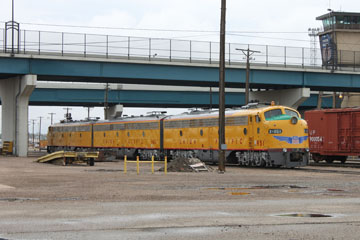
These are the last of sixty-nine E9s bought for UP’s streamliner and domeliner passenger trains. Delivered in 1955, they pulled such trains as the City of Los Angeles, City of Portland, City of San Francisco, City of St. Louis and Challenger.
#949 spent time as CNW #511 and RTA #511. #963 also spent time as AMTK #468, #1919 and #669, as well as ARR P-7. #951 was loaned to the sponsors of the American Freedom Train in 1974. Repainted red, white and blue, it hauled the "Preamble Express" in advance of the steam-powered Freedom Train in 1975 and 1976.
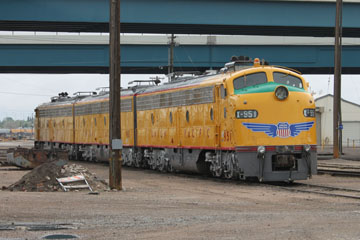
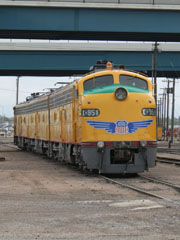
EMD built one hundred E9 A units and forty-four B units from 1954 to 1964, all for US railroads. It was the last in the highly successful E unit series, and differed from the earlier E8 by having two newer 1,200 hp 12 cylinder EMD 567C prime movers powering two GM D27 generators driving four EMD D78 traction motors.
These 70’ 3” long, 316,000 lb A units (290,000 lb B units) were updated by the UP in 1993 with EMD 16-645E prime movers
developing 31,000 lbs continuous tractive effort at 11 mph and 8,000 lbs at their top speed of 85 mph.

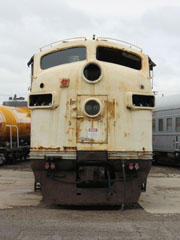
This F7 unit was built in 1949, one of seventy-two A units rostered by the Chicago & Northwestern, which also bought twenty-two B units. You can see another ex-CNW F7, #414, on the Illinois Railway Museum Yard page of this website.
Two thousand, three hundred and sixty-six F7 A and one thousand,
four hundred and eighty-three B units were built from 1949 to 1953 by EMD and its Canadian subsidiary, GMD. Weighing 230,000 lbs and 50' 8" long, they have a 567B 16 cylinder prime mover powering a GM D12B generator driving four GM D27C traction motors.
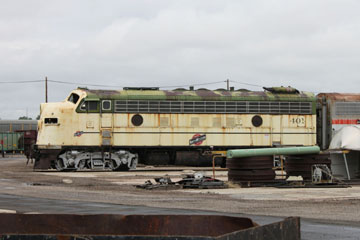
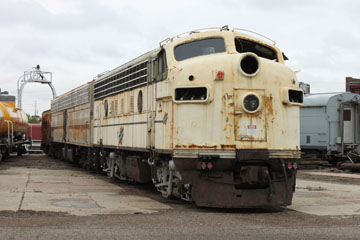
The fourth in EMD's line of F-unit locomotives, the F7 was the best-selling cab unit of all time. It succeeded the F3 and was replaced in turn by the F9. Final assembly was at EMD's La Grange, IL, plant or GMD's London, ON, facility. Promoted as a freight-hauler, it also hauled passenger trains and many stayed in service for decades.
A number of F7s have survived. You can see more on the California State Railroad Museum, the B&O Railroad Museum Yard & Car Shop and the Museum of the American Railroad pages of this website.
Above and left, another UP E9 B unit, #966, is coupled behind #401. Like #949, #951 and #963, it was bought to haul UP’s passenger trains in 1955. After Amtrak took over national passenger services in 1971, it spent time as AMTK #446, #1920 and #670 before being reacquired by the Union Pacific. It is currently not operational.
Many E9s have survived, and some are still in service. You can see more on the Gold Coast Railroad Museum page of this website, the National Museum of Transportation, St. Louis Yard page and the Illinois Railway Museum Yard page.

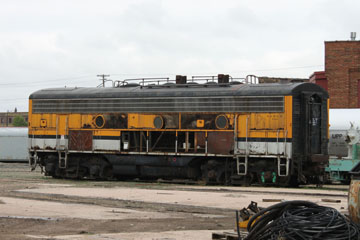
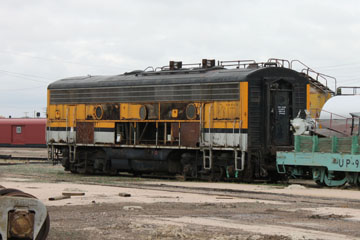
#5763 is an EMD F9 B unit built for the Denver & Rio Grande Western. The D&RGW bought four F9 A units in 1955 (#5531, #5571, #5771 & #5774) and four F9 B units (#5772, #5773, #5753 & #5763). The B unit is 50' long and weighs 228,00 lbs. A Winton 567C 16 cylinder prime mover powered a 1,750 hp
GM D12D Generator to drive four GM D37
traction motors delivering 40,000 lbs continuous tractive effort at 9.3 mph with a top speed of 65 mph.
Two other DRGW F9s have survived: #5771 and #5762 are at the Colorado Railroad Museum.


